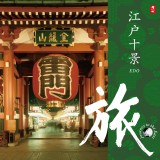|

PMR-0093 |
Journey to the East EDO
01. SPIRIT from "Asian Drums" / Kiyoshi Yoshida |
|
The city of Edo (Tokyo) prospered under the Tokugawa rule, which lasted for 260 years, from 1603 to 1867. The city consisted of 808 towns, and was the home to a million people. It was the largest city in the world at that time. Today, we can see many vestiges of Edo while walking through the streets of downtown Tokyo. The Ningyocho area holds many shops, which have been there since the Edo era. Conveying good old-fashioned sentimentality from those days, there are shops that make and sell tsuzura (bamboo clothes boxes), Shamisen, tsukudani (food boiled down in soy sauce), and such using the same techniques as their grandfathers did. The Fudo Hall in Fukagawa was the "Edo Branch" of the famous Fudo in Narita. The music of their Goma-taki festival combines the sounds of conch shells, large drums, gongs and sutra recitation by the Buddhist priests, producing a powerful Opera-like setting. The Asakusa area, around Kaminarimon, was the shogunate officials' center of worship. It is a major spot of "pray and play" today, holding the din and bustle of an amusement district. The Tomioka Hachimangu Shrine's Fukagawa Hachiman Festival, Hie Jinja Akasaka Shrine's Sanno Festival, and Kanda Myojin Shrine's Kanda are the three major Edo festivals. There are many more festivals in Tokyo throughout the year, where you can witness traditional culture such as dashi (floats), mikoshi (portable shrines), and shishimai (lion dance). In this CD, traditional Japanese instruments such as Japanese drums, Shakuhachi (bamboo flute), and Koto are used to produce the sounds and the rhythm of Japanese spirit, and to portray scenes of the city of Edo. So as they say, "Fire and fighting are the flowers of Edo", but let's make that "spirit and festivals are the flowers of Edo"! Enjoy the energy from the scenes of Edo.
Makiko Nozaki
|
